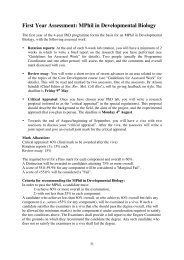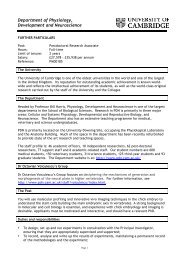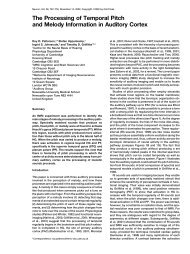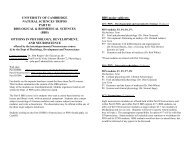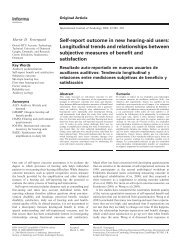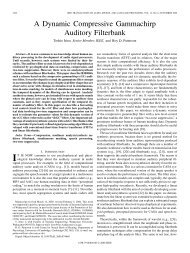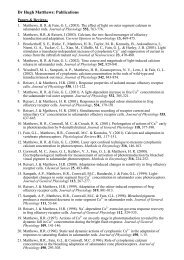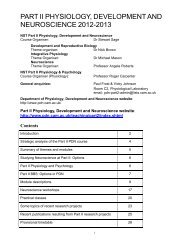FRIDAY MORNING, 20 MAY 2005 REGENCY E, 8:30 A.M. TO 12:00 ...
FRIDAY MORNING, 20 MAY 2005 REGENCY E, 8:30 A.M. TO 12:00 ...
FRIDAY MORNING, 20 MAY 2005 REGENCY E, 8:30 A.M. TO 12:00 ...
Create successful ePaper yourself
Turn your PDF publications into a flip-book with our unique Google optimized e-Paper software.
<strong>FRIDAY</strong> <strong>MORNING</strong>, <strong>20</strong> <strong>MAY</strong> <strong>20</strong>05<br />
<strong>REGENCY</strong> A, 8:<strong>00</strong> <strong>TO</strong> 10:<strong>00</strong> A.M.<br />
Session 5aBBa<br />
Biomedical UltrasoundÕBioresponse to Vibration: Hemostatis and Bleeding Detection<br />
Tyrone M. Porter, Chair<br />
Univ. of Cincinnati, Biomedical Engineering, 231 Albert Sabin Way, Cincinnati, OH 45267-0761<br />
Contributed Papers<br />
8:<strong>00</strong><br />
5aBBa1. Vector-Doppler ultrasound for the detection of internal<br />
bleeding. Bryan W. Cunitz, Peter J. Kaczkowski, and Andrew A.<br />
Brayman Ctr. for Industrial and Med. Ultrasound, Appl. Phys. Lab.,<br />
Univ. of Washington, 1013 NE 40th St., Seattle, WA 98105<br />
A vector Doppler VDop ultrasound system uses a transmitter and a<br />
spatially separated pair of receivers to measure bistatic scattering from<br />
blood. VDop has two principal advantages over color-flow Doppler in<br />
identifying internal bleeding: 1 measures flow direction, and thus absolute<br />
magnitude of flow velocity 2 does not require special orientation to<br />
detect and measure flow, thus can measure flows perpendicular to the<br />
transmitter. Our hypothesis is that real-time flow direction and magnitude<br />
can be used to detect and characterize internal bleeding. A real-time vector<br />
Doppler system has been built and tested in vitro. The system is capable of<br />
measuring flow magnitude and direction up to 145 cm/s at a depth of 3.6<br />
cm at a processing rate of 10 Hz. Accuracy was measured using a calibrated<br />
moving string phantom and the system performs well within a<br />
useful range. A blood flow phantom was developed to mimic arterial flow<br />
into an open cavity as well as into tissue and replicate both pulsatile flow<br />
as well as the energy storage due to vascular elasticity. Flow signature data<br />
is gathered under conditions of normal branching flow, and vessel breach.<br />
The talk will describe the VDop system and the flow phantom and summarize<br />
results.<br />
8:<strong>30</strong><br />
5aBBa3. A pulsatile flow phantom for image-guided high-intensity<br />
focused ultrasound studies on blood vessels. Robyn Greaby and<br />
Shahram Vaezy Ctr. for Medical and Industrial Ultrasound, APL, Univ.<br />
of Washington, 1013 NE 40th St., Seattle, WA 98105-6698,<br />
rgreaby@u.washington.edu<br />
A pulsatile flow phantom has been developed for controlled studies of<br />
acoustic hemostasis and high intensity focused ultrasound HIFU effects<br />
on blood vessels. The flow phantom consists of an excised carotid artery<br />
attached to a pulsatile pump and embedded in an optically and acoustically<br />
transparent gel to create an ex vivo model of a human artery. The artery<br />
was punctured with a needle to simulate percutaneous vascular injury. A<br />
HIFU transducer with a focal distance of 6 cm and a frequency of 3.33<br />
MHz was used to treat the puncture. B-mode and power-Doppler ultrasound<br />
were used to locate the site of the puncture, target the HIFU focus,<br />
and monitor treatment. Also, the effects of vascular flow on HIFU lesions<br />
were studied by treating vessels in the phantom for different times at a<br />
variety of flows. In both studies, histology was done on the artery. In nine<br />
trials, HIFU was able to provide complete hemostasis in 55 31 s. It is<br />
feasible to use the flow phantom to study acoustic hemostasis of blood<br />
vessels. Histology shows that the flow in the phantom appears to diminish<br />
the vascular damage from HIFU.<br />
8:15<br />
5aBBa2. Color-Doppler guided high intensity focused ultrasound for<br />
hemorrhage control. Vesna Zderic, Brian Rabkin, Lawrence Crum, and<br />
Shahram Vaezy Appl. Phys. Lab. and Bioengineering, Univ. of<br />
Washington, 1013 NE 40th St, Seattle, WA 98105,<br />
vesna@u.washington.edu<br />
To determine efficacy of high intensity focused ultrasound HIFU in<br />
occlusion of pelvic vessels a 3.2 MHz HIFU transducer was synchronized<br />
with color-Doppler ultrasound imaging for real-time visualization of flow<br />
within blood vessels during HIFU therapy. HIFU was applied to pig and<br />
rabbit pelvic vessels in vivo, both transcutaneously and with skin removed.<br />
The in situ focal intensity was 4<strong>00</strong>0 W/cm 2 on average. Vessel occlusion<br />
was confirmed by color or audio Doppler, and gross and histological observations.<br />
In rabbits, five out of 10 femoral arteries diameter of 2 mm<br />
were occluded after <strong>30</strong>–60 s of HIFU application. The average blood flow<br />
reduction of 40% was observed in the remaining arteries. In pigs, out of 7<br />
treated superficial femoral arteries 2 mm in diameter, 4 were occluded,<br />
one had 80% blood flow reduction, and 2 were patent. In addition, 3 out of<br />
4 superficial femoral arteries, punctured with 18 gauge needle, were occluded<br />
after 60–90 s of HIFU application. Larger vessels diameter of 4<br />
mm were patent after HIFU treatment. Doppler-guided HIFU has potential<br />
application in occlusion of injured pelvic vessels similar to angiographic<br />
embolization.<br />
8:45<br />
5aBBa4. High throughput high intensity focused ultrasound „HIFU…<br />
treatment for tissue necrosis. Vesna Zderic, Jessica Foley, Sean<br />
Burgess, and Shahram Vaezy Appl. Phys. Lab. and Bioengineering,<br />
Univ. of Washington, 1013 NE 40th St., Seattle WA 98105,<br />
vesna@u.washington.edu<br />
To increase HIFU throughput, a HIFU transducer diameter of 7 cm,<br />
focal length of 6 cm, operating frequency of 3.4 MHz, coupled to an<br />
imaging probe ICT 7-4, Sonosite, was driven by 1<strong>00</strong> W driving unit with<br />
5<strong>00</strong> W amplifier. A water pillow connected to a circulation pump with<br />
degassed water provided transducer coupling and cooling. Input electrical<br />
power was 4<strong>00</strong> W, corresponding to focal intensity of 51 <strong>30</strong>0 W/cm 2 in<br />
water. HIFU was applied transcutaneously in porcine thigh muscle in<br />
vivo, and intraoperatively in liver hilum, for <strong>30</strong>–60 s. After <strong>30</strong> s of treatment,<br />
muscle lesions had diameter of 2.10.4 cm and length of 2.0<br />
0.4 cm. After 60 s of treatment, muscle lesions had diameter of 3.1<br />
0.9 cm and length of 3.11.0 cm. In few cases of severe skin burns, the<br />
lesions were formed immediately under the skin and were shallow<br />
(1 cm). Liver lesions had diameter of 2.10.3 cm and length of 2.3<br />
0.6 cm. In comparison, after the <strong>30</strong> s treatment with our standard HIFU<br />
device focal intensity of 27 <strong>00</strong>0 W/cm 2 , in water the muscle lesions had<br />
diameter of 1.<strong>30</strong>.6 cm and length of 1.10.6 cm. High power HIFU<br />
device can quickly coagulate large tissue volumes.<br />
2584 J. Acoust. Soc. Am., Vol. 117, No. 4, Pt. 2, April <strong>20</strong>05 149th Meeting: Acoustical Society of America 2584



